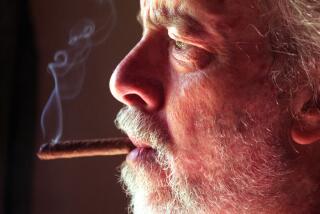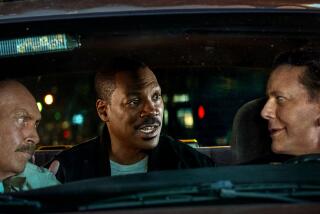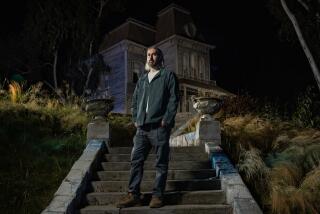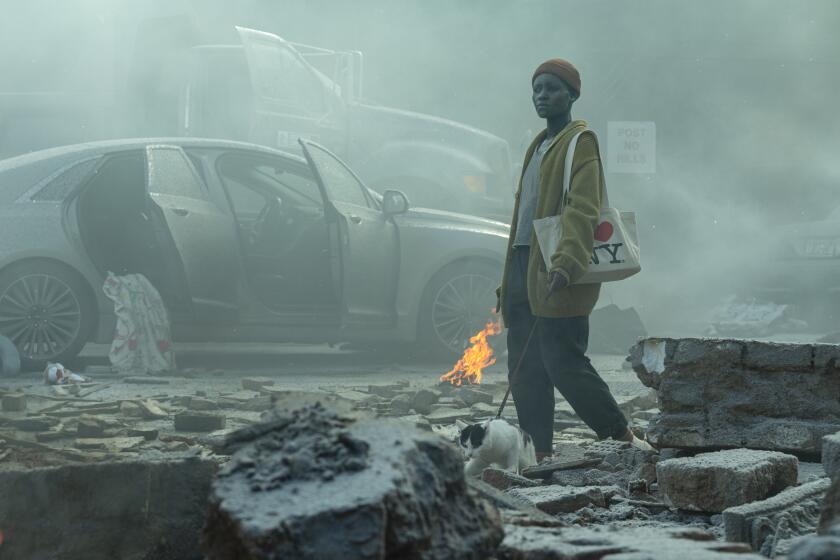How Hitchcock Fought Nazis : The Master Made Two Propaganda Films That Haven’t Been Seen Here, Until Now
Even the most ardent Alfred Hitchcock buffs, who know every twist and turn of every film and TV episode the master of suspense presented, are in for a surprising cinematic treat next month with the release on video of two short Hitchcock films never before seen in the Unites States.
The intricately plotted films--the 26-minute “Bon Voyage” and the 31-minute “Aventure Malgache”--were made in 1944 when, at the request of the British Ministry of Information, Hitchcock returned to England from Hollywood to make anti-Nazi propaganda movies. The bilingual Hitchcock was asked to film the movies in French, so they could be smuggled into Occupied France to be shown to Resistance fighters there. But the films, which the ministry ultimately deemed “too subversive” and cynical to be used as propaganda films, have languished in the possession of the British government since the ‘40s.
*
Los Angeles Hitchcock fans will also be able to see them on the big screen, May 11 and 12 at the New Beverly Cinema, which will do full justice to the films’ superb black-and-white cinematography by Gunther Krampf, a German who was then in exile in Britain. The films, a cooperative venture of Milestone Film & Video in New York and the British Film Institute, are both in French and carry English subtitles provided by British film scholar Tom Milne.
When British officials finally screened the two films, not too surprisingly, they were stunned to learn they had been given something quite different from what they had bargained for. The films are subtle, intricate, carefully detailed film noir, models of compression and resourcefulness (and clearly show the work of Hitchcock at his prime, coming as they do between “Shadow of a Doubt” and “Spellbound”), with Hitchcock clearly relishing pushing the limits of exceeding a limited budget (Hitchcock himself was paid a nominal fee) and shooting schedule.
The films were shot between Jan. 20, 1944, and Feb. 25, 1944, at the Associated British Studios at Welwyn Garden City. Both featured members of the Moliere Players, a French exile group that included many amateur actors, many of whose families were still in France.
In the first, “Bon Voyage,” a young Scottish RAF gunner (British actor John Blythe), who has escaped from a POW camp in Germany, makes his way to London, where he is interviewed by an officer of the Free French Intelligence. In flashback, the gunner, Sgt. Dougal, who’s amusingly always hungry, tells how he was helped by another escapee, a Pole, and made his way through France with the help of the Resistance.
When the officer tells the sergeant that the Pole was really a Vichy spy out to uncover as many members of the Resistance as possible, this triggers a rerun, in flashback, of the sergeant’s journey, which takes on a whole new meaning, with many subtle details revealed. At once a homage to the Resistance and a cautionary tale, “Bon Voyage” was actually smuggled into France during the war, where it had limited exposure.
“Bon Voyage” was written by J.O.C. Orton and Angus McPhail from an idea by Arthur Calder-Marshall.
In 1967, Hitchcock told Francois Truffaut, in their book-length interview, that during the making of “Bon Voyage” he had to bear in mind the serious hardships faced by the French who were his intended audience.
“In (one) shot, I showed a restaurant. Ordinarily you would never think about the look of a table where a meal has been finished. But in representing a French restaurant of the day, you did. There are no crusts left on the table. If I permitted anything like that, it would simply mean to future French audiences that the people who made the picture didn’t know what they were doing.”
He also learned, he told Truffaut, how divided the Free French really were. That essential conflict became the subject of “Aventure Galgache,” in which a French lawyer, formerly a resident of Madagascar, plays himself in a dramatization of his experiences helping compatriots escape to join De Gaulle. The lawyer, Clarousse, tells his story with much humor to his fellow actors in a dressing room of the Moliere Player’s theater; this device allows Hitchcock to cut back to the dressing room for some quick exposition and to underline the satirical tone with which he treats the lawyer’s enemies, a corrupt group loyal to the Vichy Government.
Written by Hitchcock with noted French actor Claude Dauphin, “Aventure Malgache,” although it saluted the heroism of Clarousse and others, revealed the ambiguity and treachery among the French themselves to an extent surely not equaled until Marcel Ophuls’ 1970 documentary “The Sorrow and the Pity.” Naturally this was further than the Ministry of Information had intended the film to go and “Aventure Malgache” never made it to France.
Patricia Hitchcock O’Connell, the director’s daughter, reached by phone at her home in Solvang, said that while she didn’t remember her father’s talking much about the films, she remembers clearly how she and her mother had to stay behind in Bel-Air while her father traveled to war-torn London.
Hitchcock originally was to make his shorts for American audiences rather than for the French. Yet it was David O. Selznick who, when asked his opinion of the films, declared that they were “too inferior” for the U.S. market. And when the British government requested the services of Hitchcock, Selznick, to whom he was under contract, balked at releasing his greatest director and finally relented--only with the proviso that while in London Hitchcock would at the same time continue working on the script for “Spellbound.”
More to Read
Only good movies
Get the Indie Focus newsletter, Mark Olsen's weekly guide to the world of cinema.
You may occasionally receive promotional content from the Los Angeles Times.






